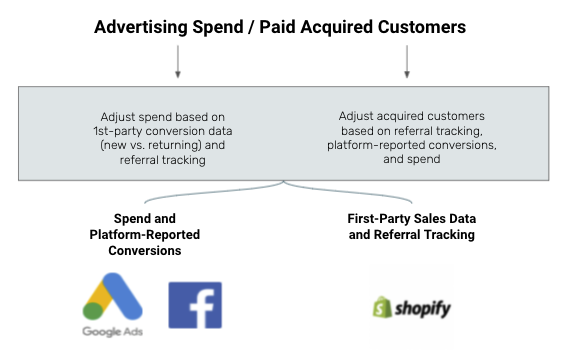A condensed version of this article was previously published on AdExchanger.
We’ve seen an absolute explosion in independent ecommerce entrepreneurship over the past year. But the industry is confronting headwinds on two fronts: a dramatic impact on measurement caused by Apple’s iOS 14.5 and acquisition costs that continue to increase unabated.
Everything You Want to Know About eCommerce Customer Acquisition Costs (CAC)
Merchants know that profitable growth is key to their success, and measuring customer acquisition costs (CAC) is a foundation for that growth.
Here, we’ll cover a new approach to calculating CAC, best practice methods to apply this metric in your business planning, and where the future of customer cost measurement may lead.
This initial entry has a few objectives:
- Tackle the deceptively challenging nature of CAC for retail e-commerce brands
- Survey standard market approaches
- Introduce a new methodology that addresses some shortcomings in the standard methods
What is CAC?
Let’s start with the basics. Customer Acquisition Cost (CAC) is a metric that describes how much it costs to use paid marketing to acquire a new, paying customer. It’s used in all sorts of verticals – from B2C retail to B2B software as a service (SaaS) – to understand a firm’s readiness to scale acquisition costs profitably.
It’s worth dissecting the formula because, while it appears simple, there’s a fair amount of nuance.
AdvertisingSpend / PaidAcquiredCustomers
In order to drive key business decisions, your methodology has to account for questions such as:
- How to measure true customer acquisition cost?
- How to define paid, net-new customers?
- How to account for (and attribute the cost associated with) the influence of your paid marketing on customers who appear to be driven outside of those channels?
The Retail Challenges
Unlike companies with recurring and predictable lifetime value (LTV ), such as subscription media companies, retail businesses are constantly fighting for the next purchase – especially from customers they’ve already acquired. That means a material amount of their marketing budget is going toward incremental purchases, including retention and reengagement. Recent attribution changes; multiple email, sms and organic marketing campaigns; and Excel-based analytics are other factors that make it challenging to calculate CAC.
That’s led to a whole range of techniques that merchants use, not all of which are particularly effective in answering the questions above.
How to Calculate CAC
Let’s first look at a handful of common methods. All of these metrics provide interesting insights — especially when compared against each other. However, we want to understand the benefits and drawbacks of each so we can apply them in the right context.
Five key metrics:
- Cost of Transaction
- CAC, Simple
- CAC, Simple – Paid Channels
- CAC, Modeled
COST OF TRANSACTION
The simplest approach is what we call Cost of Transaction. This metric is most similar to a ROAS (return on ad spend) metric – i.e., it takes your total marketing spend and divides it by the total number of conversions, not customers.
Key Limitation: This is helpful to simplify the complex relationship between cross-campaign marketing costs and new purchases, but it does not represent customer acquisition costs.
CAC, SIMPLE
When it comes to CAC, the most basic approach is to take your total marketing spend and divide it by the number of new customers over a particular period. Often people use Google Analytics to get this number, but the best approach uses your actual first-party data to determine the number of new customers.
Key Limitation: Although this is a very common method, it does not separate direct and organically acquired customers vs. those drive by your paid marketing. Nor does it adjust your total marketing costs to consider only acquisition spend.
CAC, SIMPLE – PAID CHANNELS
Many merchants understand the above limitation, and try to improve upon CAC, Simple by taking total marketing spend and dividing it by the number of new customers acquired via paid channels. Let’s call this CAC, Simple – Paid Channels, in which either first-touch or last-touch referral tracking can be used.
However, we know that customers take multi-channel paths before a purchase, so a material number of customers that were referred by non-paid channels were influenced by your paid marketing. This is the paid-channel spillover effect (in common parlance, ‘a rising tide lifts all boats’).
It really can take two forms:
- Paid marketing’s impact on customers that seem to arrive via non-paid referrer sources
- Post-impression conversion, which are data controlled by the walled gardens and very challenging to incorporate without statistical methods
Key Limitation: This can overstate your true CAC because it is not accounting for all customers influenced by your marketing – only those with a post-click referral.
CAC, MODELED
A preferred approach incorporates all of the key signals – post-impression and post-click referrals and acquisition-focused marketing costs.
When we combine the best of people-based analytics, multi-touch attribution and marketing mix modeling – and apply them to the CAC domain – we end up with a present-day worthy customer cost analytics framework that is accurate, actionable and adaptable to the new digital ecosystem.
This is where Decile’s methodology comes to play.
First, we use a regression analysis to incorporate all of the material signals — from platform-reported conversions, to referral tracking, to acquisition marketing costs.
Second, we adjust your marketing costs to limit to the portion going towards acquisition. In a pure form, CAC usually includes only costs incurred acquiring new customers — not retention and re-engagement campaigns, for example. But that is easier said than done. Often all marketing costs are included— i.e., leading to an upper-bound CAC; or analysts will divide up costs according to the marketing effort’s intent and include only costs from known acquisition efforts.
We know we can do better than including all customer costs, and it’s clear that a marketer’s intent is too brittle a foundation on which to build a measurement framework. In fact, many acquisition campaigns end up influencing retention.
Rather, we look at your first-party purchase data to get a ratio of new vs. returning customers by channel, and weigh paid marketing costs by that ratio. Similar approaches may use Google Analytics visitor data to get this ratio, but the cookie-based nature of that data makes it less reliable. This leads us to CAC, Modeled — perfectly suited for the payback analyses we will cover in the second installment.

Given the range of options that exist for calculating CAC, we believe that you actually should have multiple measures on hand. It’s important to know your cost floor — usually Cost of Transaction — as well as your cost ceiling — usually CAC, Simple – Paid Channels. And because these measures capture different elements of customer costs, monitoring their dynamics is equally insightful.
Wrapping It Up
Let’s acknowledge that CAC has a deceptively simple formula, with a number of interesting nuances to consider. While certain solutions are often sufficient for businesses with simpler marketing plans, e-commerce retail merchants should look beyond last-touch attribution and adjust costs to account for concurrent retention efforts.
That said, each methodology provides its own important signal. So customer cost analytics should include multiple metrics that best describe the underlying dynamics — not just one metric that represents the business’s conventional approach.
Customer-cost analytics is an extremely important part of profitable growth. Getting to the right CAC methodology will pay dividends as you optimize acquisition, retention, products and pricing – and it requires looking beyond your business’s conventional approach.
Decile is a data and analytics platform that tracks customer behaviors at an individual level providing you with quick access to visualizations of the key metrics across your business.
To learn more, contact sales@decile.com.

